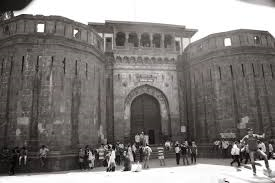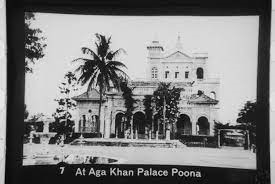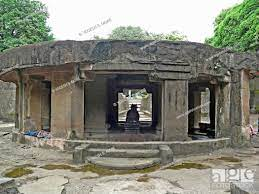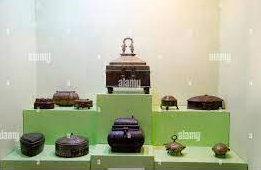A Journey Through History, Spirituality, and Natural Beauty
1.1 ) Shaniwar Wada: Unraveling the Intricacies of Pune’s Historic Fortress

Location: Shaniwar Wada is situated in the heart of Pune, Maharashtra, India. Nestled within the bustling city, it stands as a testament to Pune’s rich historical heritage.
Construction and History:
- Shaniwar Wada was built in 1732 by Baji Rao I, the Peshwa (Prime Minister) of the Maratha Empire, as the residence of the Peshwas.
- The construction of the fort began on a Saturday (Shaniwar in Marathi), giving it the name “Shaniwar Wada.”
Architecture:
- The architecture of Shaniwar Wada reflects a blend of Maratha and Mughal styles. It originally featured a massive fortification wall with five gates.
- The fort complex included several structures, courtyards, and gardens, showcasing intricate woodenwork, teak columns, and detailed carvings.
Main Features:
- Thorlya Rayancha Diwankhana: A court hall with sixteen petal-shaped seats for discussions and meetings.
- Hazari Karanje: A fountain in the shape of a lotus with a thousand jets, believed to have played music during Peshwa gatherings.
- Naachacha Diwankhana: A dance hall adorned with mirrors.
- Juna Arsa: The base structure of the five-story palace that remained after the fort was destroyed.
Ganesh Rang Mahal:
- Ganesh Rang Mahal is a noteworthy part of Shaniwar Wada, featuring exquisite frescoes and paintings.
- The walls depict scenes from the Ramayana and Mahabharata.
Bajirao’s Era and Fire Tragedy:
- Shaniwar Wada witnessed the glory of the Maratha Empire during the rule of Baji Rao I and his successors.
- In 1828, a massive fire engulfed the fort, resulting in substantial damage and leading to the decline of Shaniwar Wada’s prominence.
Haunted Legends:
- Shaniwar Wada is often associated with ghost stories, especially after dark. The most famous tale revolves around the tragic death of Narayanrao, the young Peshwa, whose spirit is believed to haunt the premises.
Light and Sound Show:
- The fort hosts a captivating light and sound show in the evenings, narrating the history of Shaniwar Wada and the events that transpired within its walls.
Visiting Information:
- Shaniwar Wada is a popular tourist attraction and is open to visitors throughout the week.
- The fort is easily accessible by public transport or private vehicles.
Shaniwar Wada, with its grandeur and historical significance, stands as a symbol of Pune’s glorious past and is a must-visit for those interested in India’s rich cultural and architectural heritage.
1.2 ) Aga Khan Palace: Unraveling Pune’s Cultural Tapestry

Location: Aga Khan Palace is situated in Pune, Maharashtra, India, on Pune Nagar Road. It holds historical significance as a key monument associated with India’s struggle for independence.
History:
- Aga Khan Palace was built in 1892 by Sultan Muhammed Shah Aga Khan III.
- The palace gained prominence during the Indian independence movement as it served as a prison for prominent leaders, including Mahatma Gandhi, his wife Kasturba Gandhi, and his secretary Mahadev Desai, who were interned here during 1942-1944.
Architecture:
- The palace is an exemplary specimen of Italian architecture with spacious lawns, elegant arches, and a blend of European and Indian design elements.
- The palace is a two-storied building with a central hall, adorned with chandeliers and historic photographs.
Memorial:
- The palace has been declared a monument of national importance by the Archaeological Survey of India.
- A memorial dedicated to Mahatma Gandhi is located in the palace complex, which includes his ashes.
Gandhi’s Imprisonment:
- Mahatma Gandhi, Kasturba Gandhi, and Mahadev Desai were imprisoned at the Aga Khan Palace from August 9, 1942, to May 6, 1944.
- Kasturba Gandhi and Mahadev Desai passed away during their internment, and their samadhis (memorials) are located on the palace grounds.
Museum:
- The Aga Khan Palace now houses a museum that showcases various personal belongings of Mahatma Gandhi and his associates.
- The museum also exhibits photographs and artifacts related to the Indian freedom struggle.
Visiting Information:
- Aga Khan Palace is open to the public throughout the week.
- Visitors can explore the museum, the palace grounds, and pay homage to the memorials of Mahatma Gandhi, Kasturba Gandhi, and Mahadev Desai.
Aga Khan Palace stands as a poignant reminder of India’s quest for independence and is a serene place that attracts visitors interested in history, architecture, and the life of Mahatma Gandhi.
1.3 ) Sinhagad Fort: Reliving History on Pune’s Majestic Hill

Location: Sinhagad Fort is located on an isolated hill in the Sahyadri mountain range, approximately 25 kilometers southwest of Pune, Maharashtra, India.
History:
- The fort has a rich history dating back to the 17th century when it was initially known as “Kondana.”
- It has witnessed several significant battles, including the famous Battle of Sinhagad in 1670, led by Chhatrapati Shivaji Maharaj to recapture the fort from the Mughals.
Architecture:
- Sinhagad Fort exhibits a mix of Maratha and Mughal architectural styles.
- The fort has well-preserved structures, including gates, bastions, temples, and a memorial to Tanaji Malusare, a Maratha general who sacrificed his life during the Battle of Sinhagad.
Notable Features:
- Kalyan Darwaza: The main entrance gate with a winding path leading to the fort.
- Tanaji Malusare Samadhi: A memorial dedicated to Tanaji Malusare, located atop the fort.
- Sinhagad Fort Top: The summit offers panoramic views of the surrounding landscape and Pune city.
Trekking:
- Sinhagad is a popular trekking destination, and several trekking trails lead to the fort from the base.
- The trek is relatively moderate, and it offers breathtaking views of the Sahyadri mountains and lush greenery.
Ganesh Temple:
- The fort houses the revered Sinhagad Fort Ganesh Temple, a place of worship frequented by both locals and tourists.
Visiting Information:
- The fort is accessible by road from Pune, and visitors can either drive or hike to reach the top.
- It is advisable to carry water and snacks during the trek.
Sinhagad Fort stands as a testament to the valor and strategic prowess of Chhatrapati Shivaji Maharaj and his Maratha warriors. Beyond its historical significance, the fort offers a delightful experience for nature enthusiasts and adventure seekers.
1.4 ) Pataleshwar Cave Temple: Delving into Pune’s Ancient Heritage

Location: Pataleshwar Cave Temple is located in the heart of Pune, Maharashtra, India. Situated in the Jangali Maharaj Road area, this ancient rock-cut temple is a hidden gem amid the urban landscape.
Architecture:
- The temple is believed to have been carved during the Rashtrakuta dynasty, making it over 1,300 years old.
- Carved out of a single basalt rock, the temple showcases remarkable rock-cut architecture typical of ancient Indian caves.
Deity:
- Dedicated to Lord Pataleshwar, a form of Lord Shiva, the temple holds religious and historical significance.
- The sanctum sanctorum houses a linga, representing the divine presence of Lord Pataleshwar.
Cave Layout:
- The temple is situated within a cave that features a circular Nandi mandapa and an inner sanctum with a Shiva linga.
- The cave complex also includes other chambers, smaller shrines, and carvings.
Nandi Mandapa:
- The entrance to the temple is marked by a beautifully carved Nandi mandapa, showcasing the sacred bull, Nandi, facing the main shrine.
Carvings and Sculptures:
- Elaborate carvings on the walls and pillars depict various mythological themes, deities, and intricate patterns.
- The attention to detail in the rock-cut sculptures reflects the architectural brilliance of the craftsmen from ancient times.
Historical Significance:
- The Pataleshwar Cave Temple is considered a protected monument, showcasing the rich historical and cultural heritage of Pune.
- It provides insights into the ancient architectural styles and religious practices of the region.
Visiting Information:
- The temple is open to the public throughout the week.
- Visitors can explore the cave temple and its surroundings, appreciating the unique craftsmanship and historical significance.
Surroundings:
- The temple is located in a serene garden, providing a tranquil atmosphere amidst the bustling city.
- It serves as a peaceful retreat for both devotees and tourists.
Cultural Events:
- The temple complex occasionally hosts cultural events, adding to the vibrancy of Pune’s cultural scene.
Pataleshwar Cave Temple stands as a timeless testament to Pune’s ancient roots, inviting visitors to marvel at its architectural splendor and delve into the spiritual ambiance of this historical site.
1.5) Raja Dinkar Kelkar Museum: A Cultural Haven in Pune

Location: Nestled on Bajirao Road in Pune, Maharashtra, the Raja Dinkar Kelkar Museum stands as a testament to India’s rich cultural tapestry. Founded by the visionary Dr. Dinkar G. Kelkar, this museum is a treasure trove of artifacts and artworks.
Founder: Established in 1962, Dr. Dinkar G. Kelkar founded the museum in memory of his son, Raja Kelkar, creating a lasting legacy of art preservation. Dr. Kelkar’s passion for art and philanthropy fueled the inception of this cultural gem.
Collection: Housing over 20,000 artifacts, the museum’s collection is a diverse representation of Indian culture, art, and history. From intricate sculptures and textiles to musical instruments, paintings, and everyday items, each piece narrates a unique story.
Artifacts:
- Sculptures: Marvel at the remarkable collection of intricately carved stone and wood sculptures, spanning different historical periods.
- Textiles: Rare and antique textiles, including sarees and garments, offer a glimpse into the rich traditions of Indian craftsmanship.
- Musical Instruments: Immerse yourself in the diverse sounds of traditional Indian music through the museum’s collection of instruments.
- Paintings: Various paintings, miniatures, and artworks depict historical events, mythological stories, and portraits, showcasing the artistic evolution of India.
Museum Sections: The museum is thoughtfully divided into sections dedicated to specific categories such as Mastani Mahal, Musical Instruments, and Everyday Art. The Mastani Mahal section is particularly intriguing, offering insights into the life and belongings of the legendary figure, Mastani.
Mastani Mahal: Step into the recreated palace interior of Mastani Mahal, a captivating attraction within the museum. This section provides a vivid glimpse into the lifestyle of Mastani, the consort of Bajirao I.
Visiting Information: The museum welcomes visitors throughout the week, inviting them to embark on a journey through India’s cultural heritage. Guided tours are available for those seeking a deeper understanding of the artifacts and their historical significance.
Educational Initiatives: Engaging in educational programs, workshops, and cultural events, the Raja Dinkar Kelkar Museum actively promotes awareness and appreciation of Indian art and heritage. It serves as a dynamic space for learning and exploration.
Legacy: A testament to Dr. Dinkar G. Kelkar’s passion, the museum has become an integral part of Pune’s cultural landscape. Drawing art enthusiasts, scholars, and tourists, it continues to contribute to the preservation and celebration of India’s diverse cultural heritage.
In essence, the Raja Dinkar Kelkar Museum is more than a repository of artifacts; it is a living, breathing cultural gem that invites visitors to unravel the intricacies of India’s artistic and historical narrative.







Leave a Reply